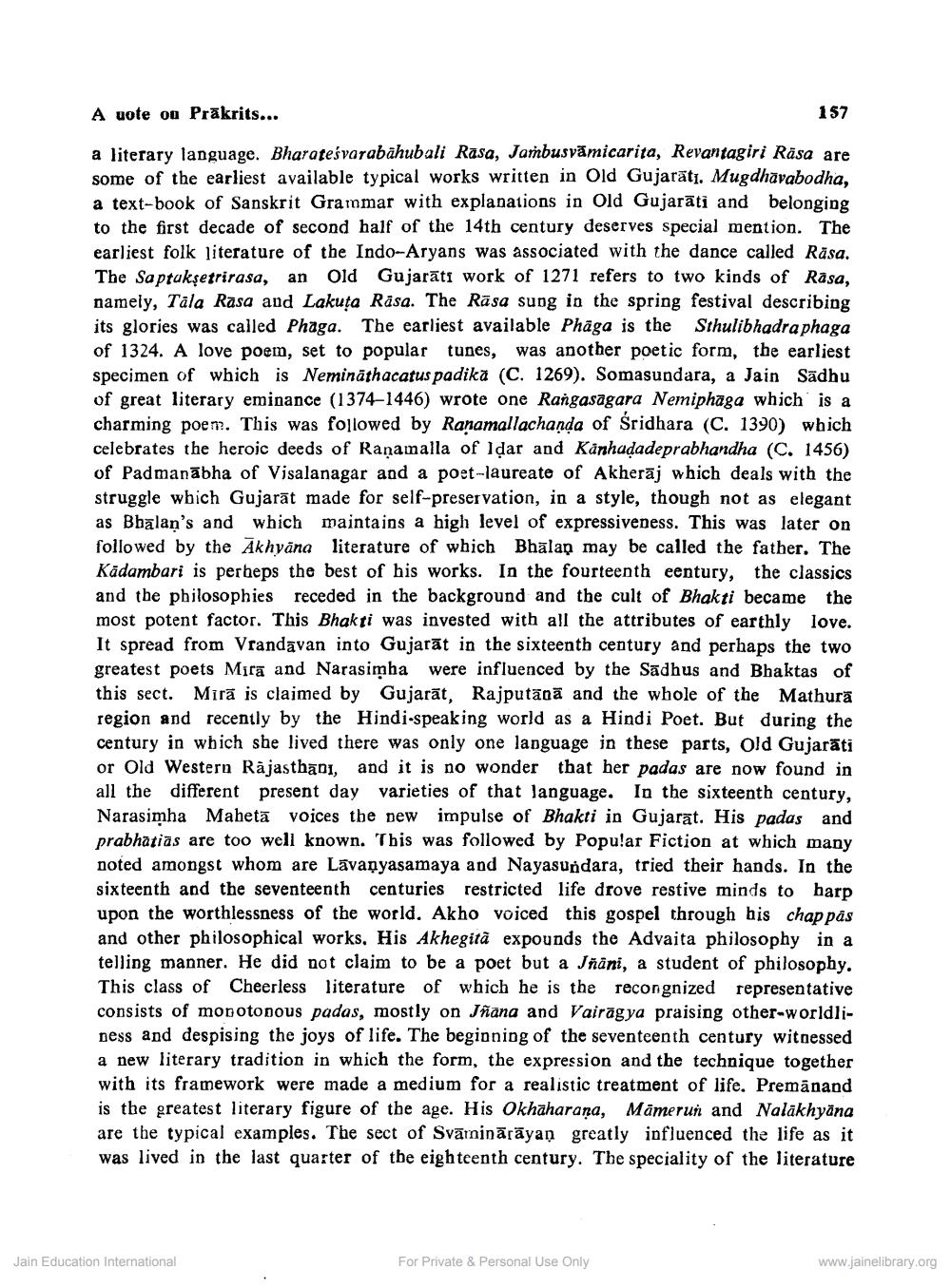________________
A uote on Prākrits...
157
a literary language. Bharatesvarabahubali Rasa, Jambusvāmicarita, Revantagiri Rāsa are some of the earliest available typical works written in Old Gujarātı. Mugdhavabodha, a text-book of Sanskrit Grammar with explanations in Old Gujarāti and belonging to the first decade of second half of the 14th century deserves special mention. The earliest folk literature of the Indo-Aryans was associated with the dance called Räsa. The Saptakşetrirasa, an Old Gujarāti work of 1271 refers to two kinds of Rasa, namely, Tala Rasa and Lakuta Rasa. The Rāsa sung in the spring festival describing its glories was called Phaga. The earliest available Phāga is the Sthulibhadraphaga of 1324. A love poem, set to popular tunes, was another poetic form, the earliest specimen of which is Nemināthacatus padika (C. 1269). Somasundara, a Jain Sadhu of great literary eminance (1374-1446) wrote one Rangasagara Nemiphaga which is a charming poem. This was followed by Ranamallachanda of Sridhara (C. 1390) which celebrates the heroic deeds of Ranamalla of Idar and Kanhadadeprabhandha (C. 1456) of Padmanābha of Visalanagar and a poet-laureate of Akherāj which deals with the struggle which Gujarāt made for self-preservation, in a style, though not as elegant as Bhālan's and which maintains a high level of expressiveness. This was later on followed by the Akhyāna literature of which Bhālap may be called the father. The Kādambari is perheps the best of his works. In the fourteenth eentury, the classics and the philosophies receded in the background and the cult of Bhakti became the most potent factor. This Bhakti was invested with all the attributes of earthly love. It spread from Vrandavan into Gujarāt in the sixteenth century and perhaps the two greatest poets Mirā and Narasimha were influenced by the Sadhus and Bhaktas of this sect. Mirā is claimed by Gujarāt, Rajputānā and the whole of the Mathura region and recently by the Hindi-speaking world as a Hindi Poet. But during the century in which she lived there was only one language in these parts, old Gujarāti or Old Western Rajasthadi, and it is no wonder that her padas are now found in all the different present day varieties of that language. In the sixteenth century, Narasimha Mahetā voices the new impulse of Bhakti in Gujarat. His padas and prabhatias are too well known. This was followed by Popular Fiction at which many noted amongst whom are Lāvanyasamaya and Nayasundara, tried their hands. In the sixteenth and the seventeenth centuries restricted life drove restive minds to harp upon the worthlessness of the world. Akho voiced this gospel through his chappas and other philosophical works. His Akhegità expounds the Advaita philosophy in a telling manner. He did not claim to be a poet but a Jñâni, a student of philosophy. This class of Cheerless literature of which he is the recongnized representative consists of monotonous padas, mostly on Jñana and Vairagya praising other-worldliness and despising the joys of life. The beginning of the seventeenth century witnessed a new literary tradition in which the form, the expression and the technique together with its framework were made a medium for a realistic treatment of life. Premānand is the greatest literary figure of the age. His Okhaharana, Māmerun and Nalākhyāna are the typical examples. The sect of Svārinārāyaṇ greatly influenced the life as it was lived in the last quarter of the eighteenth century. The speciality of the literature
Jain Education International
For Private & Personal Use Only
www.jainelibrary.org




